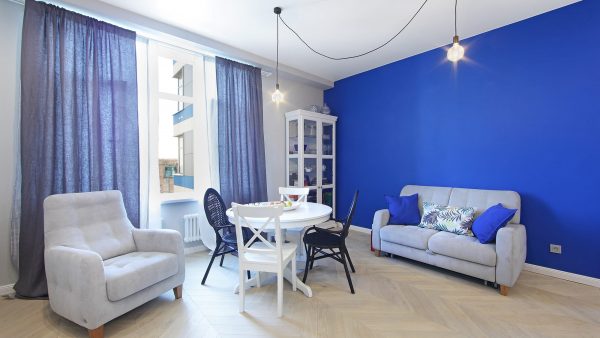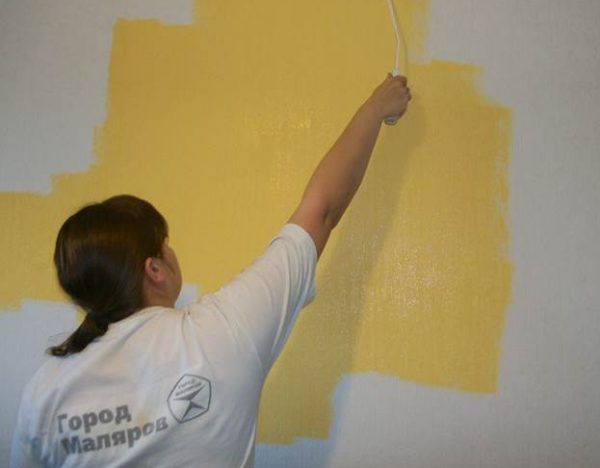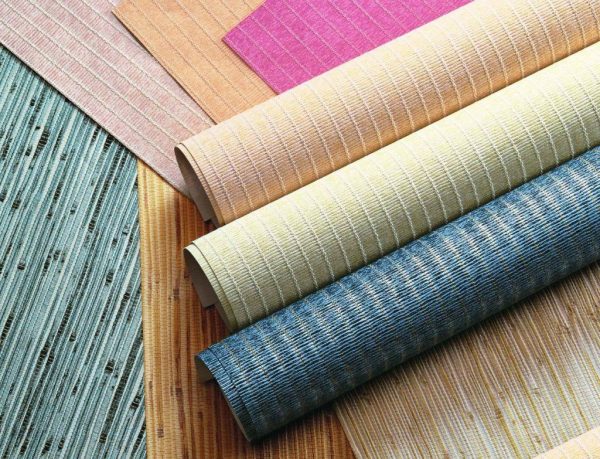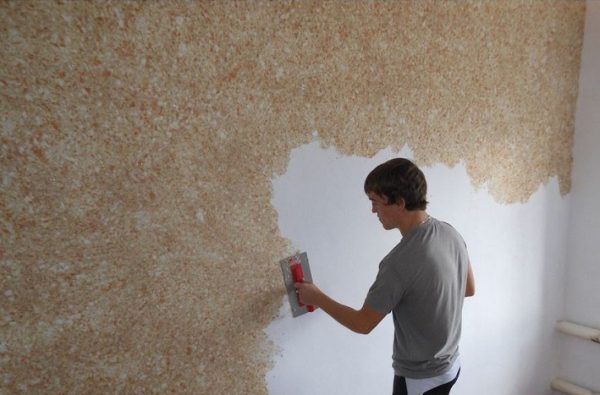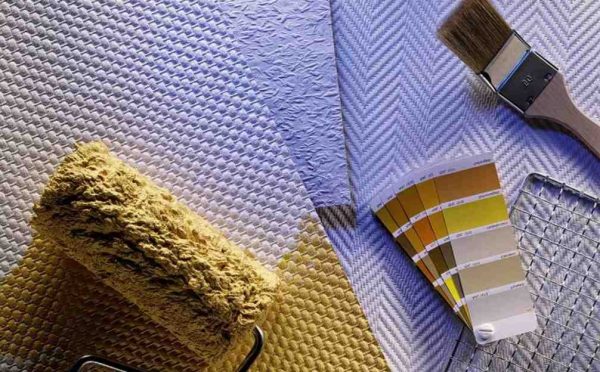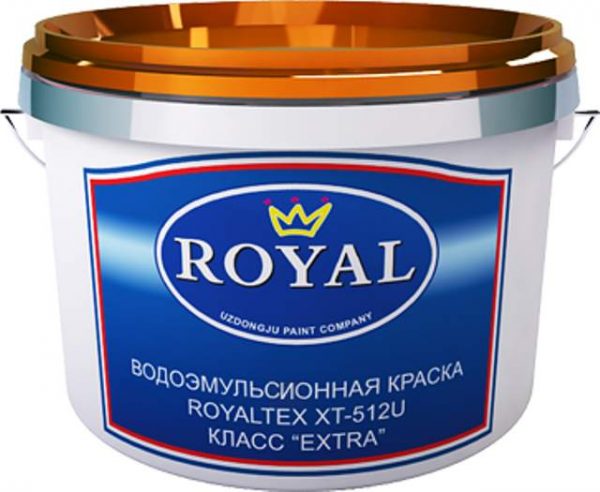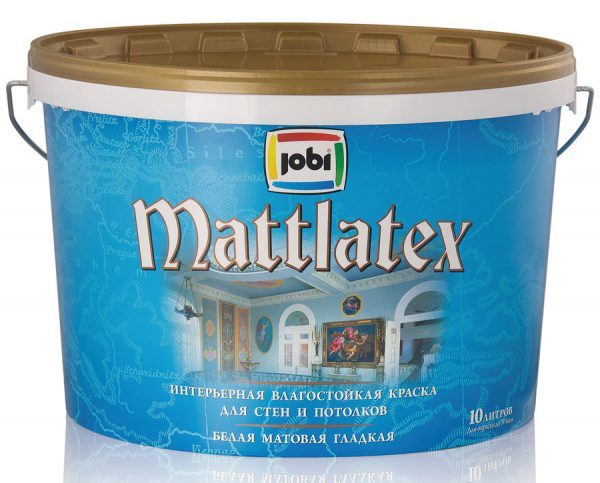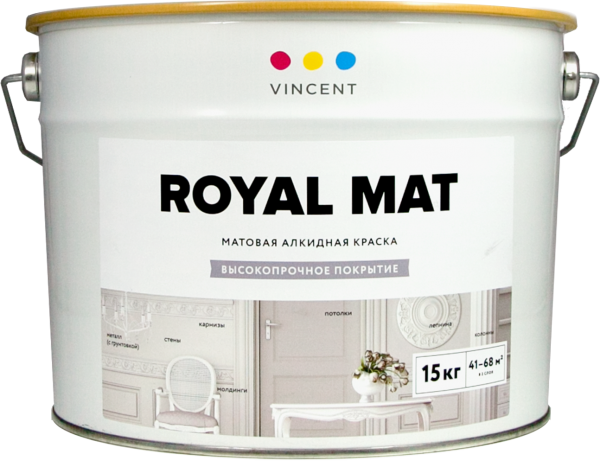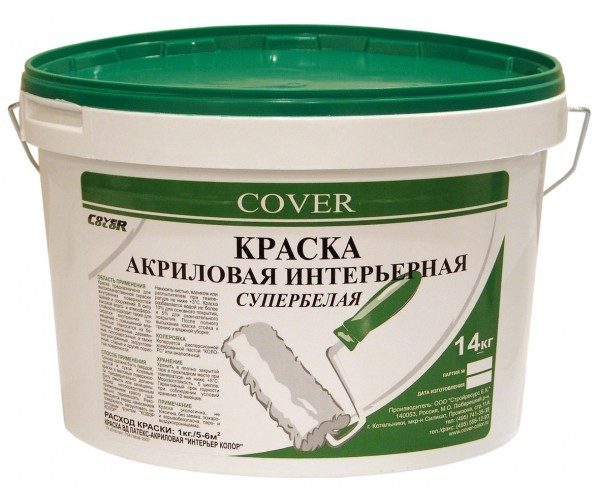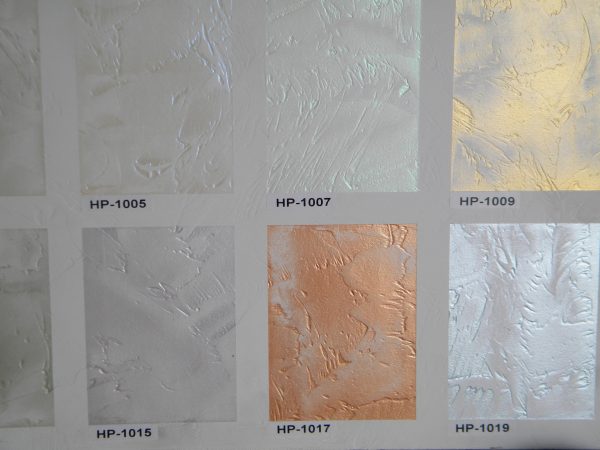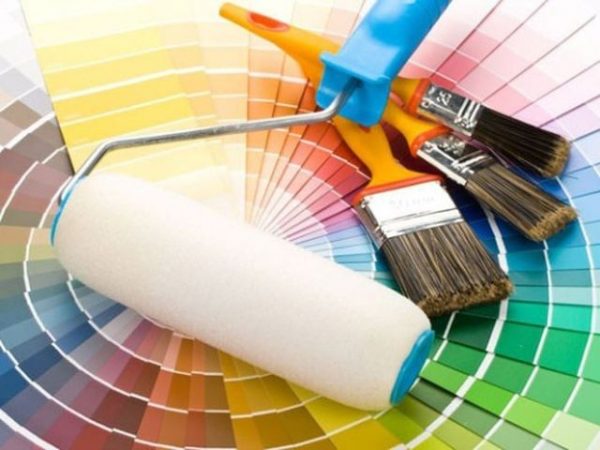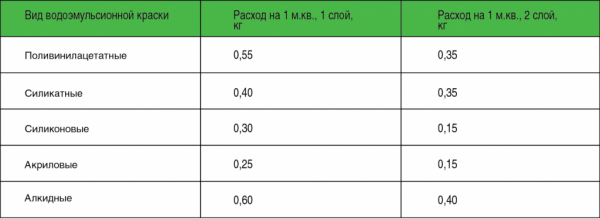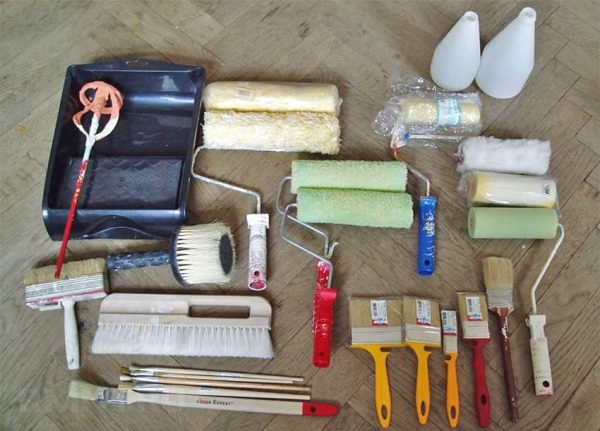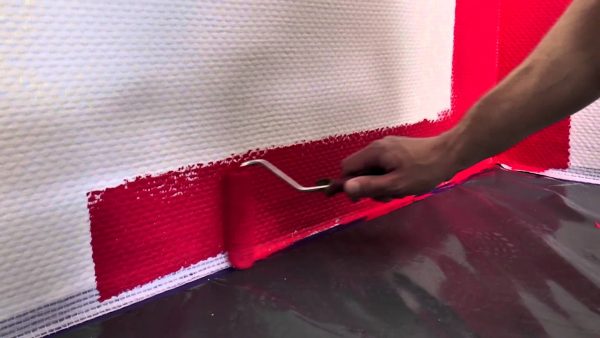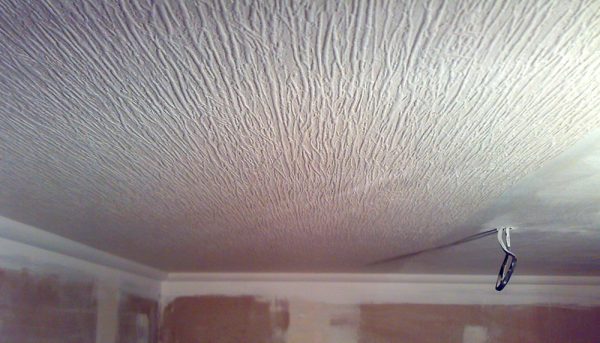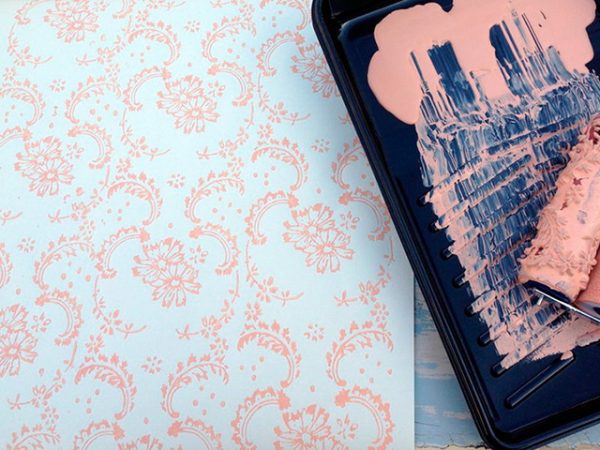It often happens that the color of the walls is bored, but there is no money for a new repair. In this situation, a good paint for wallpaper will help, because many types of paintings can be painted. There are also special materials for painting, including ceiling - non-woven, vinyl, glass.
- What wallpaper can be painted - list
- Paper wallpaper
- Vinyl wallpapers
- Non-woven wallpaper
- Liquid wallpaper
- Cullet
- Types of wallpaper paint
- Water based paints
- Latex paint
- Alkyd paints
- Acrylic paints
- Coverage Options
- Color spectrum
- Calculation of the amount of paint
- Painting tools
- Wallpaper painting process
- Drying time
- Causes of paint shedding
- Are repeat coatings possible
- Features of painting wallpaper on the ceiling
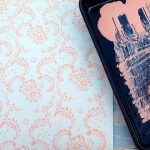
What wallpaper can be painted - list
The choice of type of wallpaper during the repair depends on many factors - budget, experience, color, evenness, smoothness of the walls, type of room. For example, in the bedroom for adults it is quite possible to use paper wallpaper, because the intensity of use of the room is small. In the children's room, paper wallpapers are also popular due to environmental friendliness, although it is better to choose more durable fiberglass cloths. The walls of the living room or hallway should be glued with vinyl or non-woven - such materials are more durable, they are difficult to scratch.
Most of these wallpapers can be repainted with their own hands. Modern paints and varnishes are suitable for painting bare walls, ceilings and wallpapers. If the walls have an old coating, painting it will have several advantages. The structure of the wallpaper is embossed, which allows you to hide minor wall defects that inevitably appear over time. The color of the paint will look more interesting than on the walls without wallpaper - this is achieved due to the play of light on a convex surface.
to contents ↑Paper wallpaper
Paper-based canvas is the simplest and most inexpensive. Their strength indicators are not the highest, therefore it is better to choose options with impregnation or immediately varnish the walls. But the gloss will visually highlight defects, and it will be very difficult to remove old paintings after varnishing. Therefore, it is worth buying embossed wallpaper with factory impregnation. Their operational properties are better, as well as decorative ones - they look like an expensive fabric.
Single-layer paper can be painted once, and only after applying a water-repellent primer. Normal two-layer wallpapers - no more than five times. If the material has an inner layer of wood fibers, it may be subject to repeated dyeing up to 7-8 times.
to contents ↑Vinyl wallpapers
Such paintings consist of two layers. The first is foamed vinyl, the second is polyvinyl chloride sprayed. Outwardly, this material is very beautiful - embossed and soft. Vinyl wallpapers can be painted up to ten times, from frequent color changes, they do not deteriorate.
to contents ↑Wallpaper made of two layers of vinyl is even more resistant to the application of a coloring agent. They repel moisture, durable, in appearance resemble tiles. Most often, these linens are glued in the kitchen, where frequent washing is required. Another option for vinyl wallpapers is silk-screen printing, here the top layer additionally contains silk fibers.You can paint such wallpapers, but the embossed surface will be smoothed out a little.
Non-woven wallpaper
Non-woven fabric is a non-woven material of two types of randomly arranged cellulose fibers and textiles. This layer is the main one; the inside of the wallpaper has paper or vinyl. Flizelin is a washable material, but if there is a paper base, it can deteriorate from the frequent ingress of water.
Non-woven wallpaper is easy to repaint, you can change the color on them up to 15 times. The fact is that non-woven is very elastic, therefore not subject to shrinkage. Painted canvases with original embossing or embossed, volumetric patterns look especially beautiful.
to contents ↑Liquid wallpaper
This material consists of several components - mica, cellulose, glue and dyes. It can also be white, without pigments. Before you apply such a wallpaper, you need to prime the walls. Next, the mass is bred according to the instructions and applied with a gun, spatula. The coating is seamless, looks very beautiful.
It is impossible to completely change the color of liquid wallpaper. Due to the strong absorption, the main shade will appear on the surface and look strange. Therefore, you can only strengthen the base tone, make it by coloring more dark. In practice, most specialists do not apply painting of such material due to the loss of the desired relief, original appearance.
to contents ↑Cullet
Wallpaper with a base of mineral material - fiberglass - can be stained, there is no risk of spoiling the material. The fibers in the wallpaper are interconnected by heating the glass, because the final product will be environmentally friendly, non-combustible, safe for home use.
Even with repeated painting, the wallpaper will not lose its relief and attractive appearance, and therefore they are most often pasted in offices, utility rooms or rooms with excessive humidity. If subsequent painting is expected, it is better to buy wallpaper on a paper substrate, rather than single-layer ones, the first ones are stronger.
to contents ↑Types of wallpaper paint
A huge number of paints are sold on the market - water-dispersible, latex and others. A correctly selected product will help change the color of the paintings, make them more juicy, vibrant. The paint always indicates what type of wallpaper it is suitable for. Some paintwork materials are not suitable for paper wallpapers, others are optimal for vinyl. Of the manufacturers, Tikkurila (Tikkurila), Dulux (Deluxe), Dyo, Halo, Marshall, Belinka, Dufa, Tex are popular. Paints are sold in banks, plastic buckets with a volume of 1-50 liters.
to contents ↑Water based paints
Water-based paint is the most inexpensive option for walls and ceilings. It is prepared on the basis of water, antiseptics, fillers, PVA glue, so the water emulsion is initially white and must be tinted. There are a lot of colors, grouped by codes (up to 1000 shades).
Advantages of the emulsion are as follows:
- environmental Safety;
- odorless composition;
- the ability to apply for decoration of any premises;
- the presence of matte and glossy options.
The disadvantage is the instability to the action of water - when processing with a wet rag, the paint is erased. After this procedure, you will have to apply a new layer, otherwise the wall will remain faded, stained. Another emulsion quickly burns out. On the walls, which are subject to the influence of the sun, it is worth applying a different paintwork material. But for decorative plaster water-based paint is suitable, it allows you to emphasize the relief and original decor of the main coating. You just need to remember that after drying, the color will be a little lighter than initially.
to contents ↑Latex paint
This type of paint is the most expensive, but the quality is on top. After drying, the walls will have a luxurious coating, silky, very pleasant to the touch, smooth. Latex (synthetic or natural rubber) will give the surface good moisture resistance, it will be easy to remove dirt and dust from the walls.There are no harmful components in latex paints, so they can be used in children's rooms and other residential premises. Consumption per 1 m2 is small, the paint is applied in a thin layer, which after drying remains breathable. Latex-based glossy paints are very durable.
They also have cons. In addition to the high price, it should be noted that not the whole palette of colors is suitable for wallpaper. Latex does not allow to achieve too bright shades, he "loves" only muted, pastel colors. This must be taken into account before starting repairs. Also, the paint may smell a little, although the smell is not very sharp. Another minus is the drying speed. You will have to work quickly to prevent sagging and noticeable transitions.
It is best to stain fiberglass or non-woven with a volume surface. The color scheme of such materials is not rich, but you can tint the white paint immediately in the desired shade. Full drying of the wall will occur in 2-4 hours, you can use the room immediately.
to contents ↑Alkyd paints
Unlike previous options, alkyd paints contain a lot of harmful components - synthetic resins, oils, solvents. They are far from good for health, therefore it is permissible to use coatings for coloring wallpapers only in non-residential premises. Staying in such a room for a long time can cause poisoning, and experimenting with your own safety is not worth it! Also alkyd paints are flammable, which greatly limits the scope of their operation.
But alkyd enamels are still used for repair work. They are saturated in shades, they can even be painted on the wall or wallpaper. There are luminous, pearlescent paints that look original after drying (they are usually used for outdoor work). Also alkyd paints are very resistant to damage, serve several years without loss of external attractiveness and protective properties. They are not harmed by high humidity and ultraviolet radiation. The composition contains antifungal additives, and rotting of the wallpaper will be ruled out. The price of alkyd paints is one of the lowest.
to contents ↑Acrylic paints
This is the most popular option for painting walls and wallpapers. Acrylic is harmless to the body, like other components. Acrylic paint is used in any room, including wet. She will not be able to smell unpleasantly, since she does not emit vapors. The material is moisture resistant, while vapor permeable, dries in a day. A fungus does not start on the surface painted with acrylic, the wallpaper does not deform. After drying, the sheets can be washed without harm to the coating.
Acrylic is suitable for all types of wallpapers, but on paper the number of colors should not be too large due to possible weighting. Ideal paint for non-woven fabric. Using fiberglass, you must first prepare the walls - to carry out a primer wallpaper. Painted, they will look very bright, which stands out from the list of analogues.
to contents ↑Coverage Options
In addition to color, before buying, you need to evaluate other effects created by the paint. Most often, users choose matte coatings. In the house, apartment, such funds create a cozy atmosphere. They absorb light, so they are more suitable for large rooms.
Semi-gloss and semi-gloss paints are ideal for bedrooms. Their ability to reflect light is moderate, and the desired level of lighting will be achieved in the room. Glossy paints strongly repel light, they should be used in small rooms located on the north side. But the walls must be completely smooth, otherwise all defects will become noticeable.
Pearlescent paints are also on sale - they change the tone depending on the lighting. Walls look best under diffused light. Paintwork with sparkles gives the effect of overflow, glare, perfectly combined with additional floor and wall lighting.
to contents ↑Color spectrum
By tinting, you can choose almost any shade for the walls. The colors are injected into white paint according to the desire of the buyer. You can choose the right tone by the paint code using a special computer program.It is also possible to create a color with your own hands when mixing different shades. Manual tinting is undesirable, because it will be difficult to repeat the result. A new portion of the paint will surely become lighter or darker. In addition, thoroughly mixing large volumes with your hands is difficult, most often there are streaks and unpainted areas.
As for the choice of color for wallpaper, you can be guided by such tips:
- for small rooms they buy light colors, beige and other pastel shades look best;
- it is permissible even in small rooms to use individual bright accents, drawings, screen images, different decor of contrasting tones;
- in large rooms you can use any tones, even dark ones, while it’s better not to overdo it, otherwise the room will look gloomy;
- for the harsh northern side, yellow and peach tones are usually chosen, which look warm and bright;
- decoration of individual sections with gold, silver and graphite paint looks beautiful.
Calculation of the amount of paint
In order to properly determine the amount of paint for repair, you need to immediately make a choice by its type. On average, about 250 g is consumed per square meter of material, but consumption can vary depending on the hygroscopicity of the wallpaper. Here are other factors to consider when calculating:
- The quality of the preparatory work. If flaws are allowed during surface treatment, consumption increases. So, without priming the walls, the absorption of paint increases by an order of magnitude, and, wanting to save, you can achieve the opposite.
- Type of paint and its suitability for a particular type of wallpaper. Some materials are universal, while others are only suitable for a specific canvas structure.
Less consumption is obtained for dense vinyl wallpaper - 150 g / sq. m If primed, the savings will be up to 100 g. Paper wallpaper can be treated with diluted glue, after complete drying, proceed to painting. To calculate the paintwork, you need to measure the area of the room, multiply by the expense, while buying material with a margin. Exact data are usually indicated on the packaging of paintwork.
to contents ↑Painting tools
Apply paint using a paint roller. It’s easy for them to work, while the area of contact will be large. A long-nap roller is best painted with a glass cloth. Foam rollers are not suitable for embossed wallpapers, they are good only for smooth paper material. The size of the small roller for narrow sections is 10 cm; the large is not worth buying with a size of less than 25 cm.
Paint brushes are used only for painting hard-to-reach places where the roller cannot be reached. These are the corners of the room, joints, floors. Also on sale there are screen rollers that allow you to apply the picture on plain coatings.
Still for work, you need such devices:
- masking tape for pasting jambs, doors, so as not to stain them with paint;
- paint cuvette (tray) - a container with a corrugated bottom, where the roller is squeezed;
- construction mixer, drill with nozzle - needed if the tinting of the paint is carried out independently;
- spray gun - usually used by professionals for applying paint over large areas.
Also, personal protection will require a respirator, a headband, gloves and special tight clothing.
to contents ↑Wallpaper painting process
The best result in dyeing can be obtained if the strips of wallpaper are glued butt, and not lapped. Before starting work, it is important to prepare:
- to take furniture and things out of the room;
- Wipe dirty stains on the wallpaper, if possible, wash old cloths (otherwise the paint will lie unevenly);
- cover the floor with film or newspapers, plinths and other unpainted elements to seal with masking tape;
- mix the paint to uniformity, even if it is not tinted;
- Pour some paint into the specially designed tray.
For painting, the roller must be lowered into the paintwork. Then roll along the ribbed surface of the tray to distribute the paint and squeeze out the excess. Wallpaper coloring begins with the upper corner of the wall, which is closer to the window. The roller is rolled along the wall with bottom-up movements. Subsequent strips are applied overlapping the edges of the previous ones. Skirting areas, other difficult areas are stained with a brush. After the first layer has completely dried, the second can be performed, although this is not necessary.
In addition to staining, you can further protect the wallpaper with colorless varnish. This will significantly increase the service life and maintain color for a long time. You can also apply different patterns using a screen roller or manually using patterns.
to contents ↑Drying time
The drying time of the paint on the walls depends on many factors:
- porosity of the base - on the varnished wallpaper, the paintwork dries longer;
- the temperature in the room - at + 20 ... + 27 degrees, the paint dries faster, but if the house is hot, the composition can become very thin;
- humidity - drier air contributes to speedy drying;
- good ventilation - air circulation (except for drafts) helps to dry the walls;
- layer thickness - the thinner the paint is applied, the sooner it will harden;
- type of paint - water-based materials dry quickly.
Most paints dry in 2-24 hours, but re-coat should not be done earlier than 12 hours. Oil formulations dry for about two days, but they are not used for painting wallpapers.
to contents ↑Causes of paint shedding
It happens that the paint begins to peel off, crack after drying. This can be observed in case of violation of the staining regime - if the second layer was applied to the dry first. Also, paint shedding is noted when the old and new coatings do not match, if the wallpaper already had a layer of a different paint. For example, applying an acrylic composition to an aqueous emulsion can lead to poor quality results.
to contents ↑Are repeat coatings possible
Coloring the wallpaper a second time is acceptable. Moreover, modern coatings withstand several stains without spoiling the appearance. So, cullet and durable interlining - up to 15 times. But there are limitations. For example, a relief pattern on wallpaper is usually painted no more than 5-7 times, then it will be very blurry. Also, it will not work to apply light paint on top of 2-3 layers of dark - the final tone will be ugly.
to contents ↑Before re-painting, you need to make sure that the old coating holds tight, there are no exfoliating zones. Otherwise, you need to sand the base well, primer and only then start work.
Features of painting wallpaper on the ceiling
For work on ceiling coatings use a paint roller or spray gun. You will also need a stepladder of the right height. You can start painting immediately after drying the wallpaper glue. Old wallpaper must first be cleaned of dust, remove pollution.
They buy water-based coatings for painting. Oil compositions, solvent based paints are not used, most often experts advise choosing acrylic compositions. To create the effect of volume, paint is applied, and then rubbed with a rag. You can also paint the canvas before gluing (for convenience). In general, the painting process is similar to that on the walls and is not difficult. With the right approach, an excellent result will surely be obtained and the room will sparkle with new shades.

